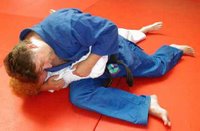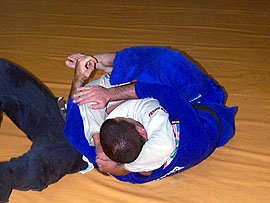The Monson Choke
Here's a breakdown of that choke, including set-up, from Donald Park aka "RGDA Ohio" at my favorite jiu jitsu message board at Jiu Jitsu Gear
This choke has nothing to do with strength.
Much like a proper RNC, it's not about squeezing the bicep. Squeezing / flexing you bicep to "crank" the choke turns this into a crank, which is much easier to resist / withstand.
I show this move a lot in my no-gi classes, though it works equally well with or without the gi(as most moves do).
(1) From passing the guard or from holding cross side, reach around the back his neck with your arm and cup your hand underneath his chin. either pass to cross side, or if he is in cross side already, remain there.
(2) Put your other, non cupping hand next to his hip so he cannot recover guard and drive your weight into his hip with your shoulder (I usually put the leg that's near his head up on the foot to drive). This will lift your opponent's head off the ground.
(3) When your opponent's head lifts off the ground, wrap deep around his neck with your cupping arm and (while keeping your other hand next to his hip on the ground to prevent guard recovery) walk to north south.
(4) Grab your hands together as if you're going for a guillotine (I call this choke the N-S guillotine, btw) and put your head either on his chest, or on the near side of it.
(5) Here are the keys to finishing: (A) you must be very flat to the ground (B)you must place your hip right next to his head. (C) it doesn't really matter if his near arm is inside your guillotine or not. In fact, I have more success finishing when his arm is inside my guillotine. The only thing you can't allow re: his arm is for his hand / elbow to be blocking your non choking foream. (i.e., if your non choking arm doesn't wrap around his armpit, but instead wraps over his forearm, then he can resist and the choke won't work. . . but the armbar is right there in that scenario).
To finish, simply SLIDE your body down and away from his head, keeping your hips flat. Continually adjust your hips such that you push his head (with your hip) away from you, constantly keeping him in a straight line. RELAX!!!!! and do not squeeze too hard, simply keep a tight lock and let your body movement lower your bicep on to his neck. This becomes a VERY tight choke and is very effective.
You'll notice that Monson did his choke with the arm outside of his guillotine grip. You'll also notice that Monson continually slid down and adjusted his hip towards Hinkle's head to keep Hinkle straight (keeps your opponent on his back and also tightens the choke).
That's our choke from north-south. I've now got choke attacks for every position from the top--including the Kron Gracie Lynch choke from half guard. Now let's see about putting this stuff into practice over the next few weeks.





